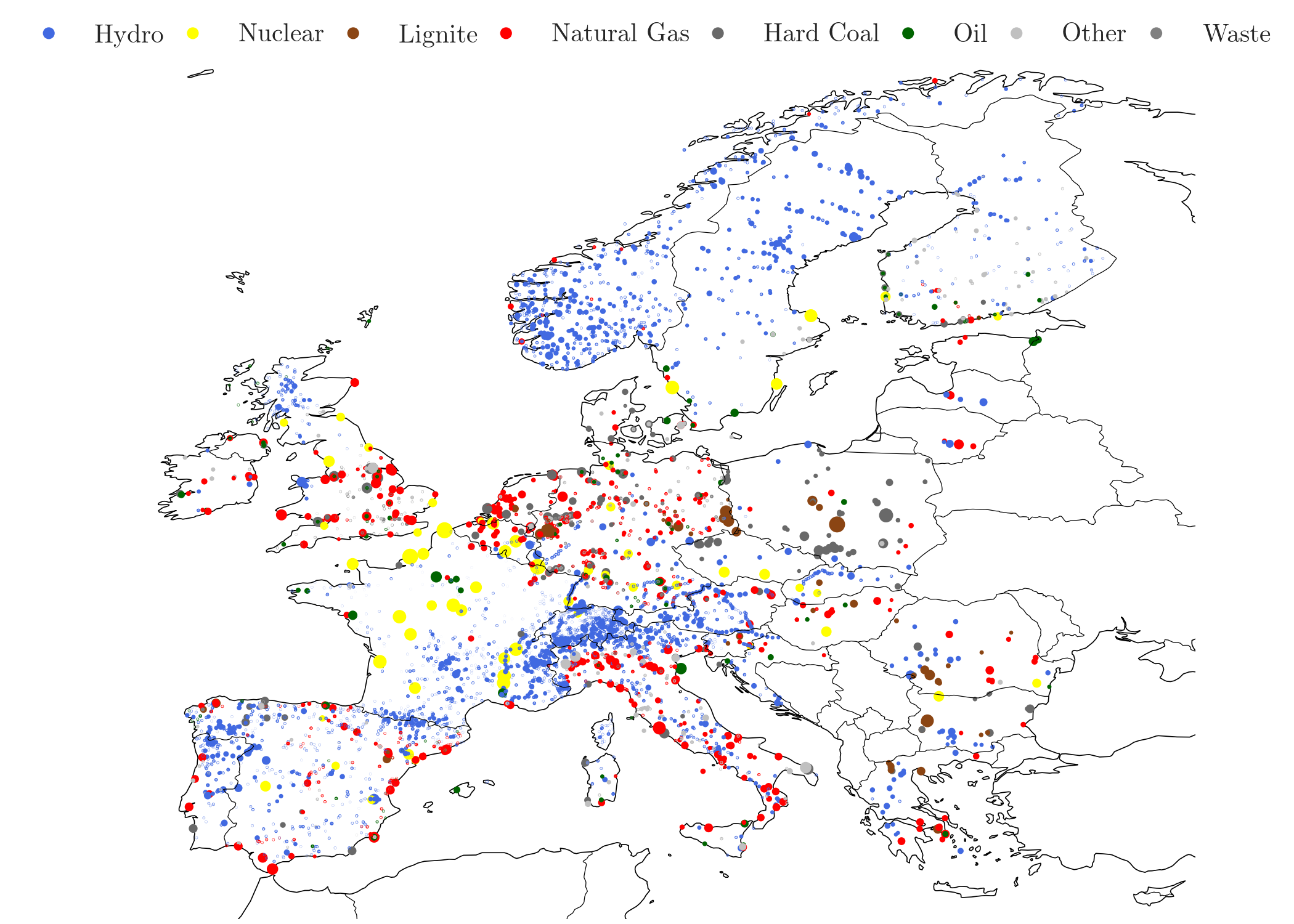Rule build_powerplants#
![digraph snakemake_dag {
graph [bgcolor=white,
margin=0,
size="8,5"
];
node [fontname=sans,
fontsize=10,
penwidth=2,
shape=box,
style=rounded
];
edge [color=grey,
penwidth=2
];
4 [color="0.61 0.6 0.85",
label=add_electricity];
6 [color="0.17 0.6 0.85",
label=base_network];
7 [color="0.58 0.6 0.85",
fillcolor=gray,
label=build_powerplants,
style=filled];
6 -> 7;
7 -> 4;
}](../_images/graphviz-19fbd679fbe7c981a4f7d2c18598cef9472c1878.png)
Retrieves conventional powerplant capacities and locations from powerplantmatching, assigns these to buses and creates a .csv file. It is possible to amend the powerplant database with custom entries provided in data/custom_powerplants.csv.
Relevant Settings#
electricity:
powerplants_filter:
custom_powerplants:
See also
Documentation of the configuration file config.yaml at
Rule add_electricity
Inputs#
networks/base.nc: confer Rule base_network.data/custom_powerplants.csv: custom powerplants in the same format as powerplantmatching provides or as OSM extractor generates
Outputs#
resource/powerplants.csv: A list of conventional power plants (i.e. neither wind nor solar) with fields for name, fuel type, technology, country, capacity in MW, duration, commissioning year, retrofit year, latitude, longitude, and dam information as documented in the powerplantmatching README; additionally it includes information on the closest substation/bus innetworks/base.nc.
Source: powerplantmatching on GitHub
Description#
The configuration options electricity: powerplants_filter and electricity: custom_powerplants can be used to control whether data should be retrieved from the original powerplants database or from custom amendmends. These specify pandas.query commands.
Adding all powerplants from custom:
powerplants_filter: false custom_powerplants: true
Replacing powerplants in e.g. Germany by custom data:
powerplants_filter: Country not in ['Germany'] custom_powerplants: true
or
powerplants_filter: Country not in ['Germany'] custom_powerplants: Country in ['Germany']
Adding additional built year constraints:
powerplants_filter: Country not in ['Germany'] and YearCommissioned <= 2015 custom_powerplants: YearCommissioned <= 2015
Format required for the custom_powerplants.csv should be similar to the powerplantmatching format with some additional considerations:
Columns required: [id, Name, Fueltype, Technology, Set, Country, Capacity, Efficiency, DateIn, DateRetrofit, DateOut, lat, lon, Duration, Volume_Mm3, DamHeight_m, StorageCapacity_MWh, EIC, projectID]
Tagging considerations for columns in the file:
FuelType: ‘Natural Gas’ has to be tagged either as ‘OCGT’, ‘CCGT’
Technology: ‘Reservoir’ has to be set as ‘ror’ if hydro powerplants are to be considered as ‘Generators’ and not ‘StorageUnits’
Country: Country name has to be defined with its alpha2 code (‘NG’ for Nigeria,’BO’ for Bolivia, ‘FR’ for France, etc.
The following assumptions were done to map custom OSM-extracted power plants with powerplantmatching format.
- The benchmark PPM keys values were taken as follows:
- ‘Fueltype’: [‘Hydro’, ‘Hard Coal’, ‘Natural Gas’, ‘Lignite’, ‘Nuclear’, ‘Oil’, ‘Bioenergy’
‘Wind’, ‘Geothermal’, ‘Solar’, ‘Waste’, ‘Other’]
- ‘Technology’: [‘Reservoir’, ‘Pumped Storage’, ‘Run-Of-River’, ‘Steam Turbine’, ‘CCGT’, ‘OCGT’
‘Pv’, ‘CCGT, Thermal’, ‘Offshore’, ‘Storage Technologies’]
‘Set’: [‘Store’, ‘PP’, ‘CHP’]
- OSM-extracted features were mapped into PPM ones using a (quite arbitrary) set of rules:
‘coal’: ‘Hard Coal’ ‘wind_turbine’: ‘Onshore’, ‘horizontal_axis’ : ‘Onshore’, ‘vertical_axis’ : ‘Offhore’, ‘nuclear’: ‘Steam Turbine’
All hydro OSM-extracted objects were interpreted as generation technologies, although [“Run-Of-River”, “Pumped Storage”, “Reservoir”] in PPM can belong to ‘Storage Technologies’, too.
OSM extraction was supposed to be ignoring non-generation features like CHP and Natural Gas storage (in contrast to PPM).
